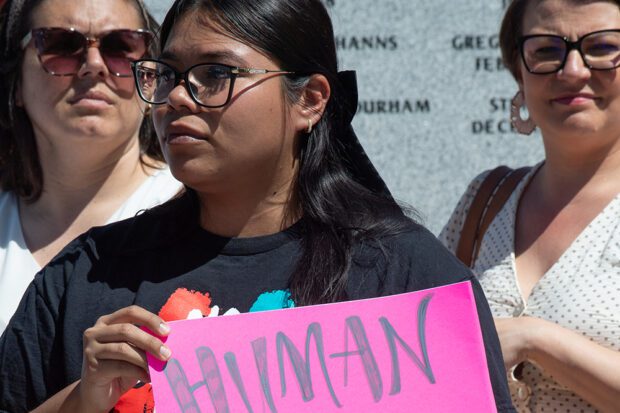
On June 13, a press conference held in front of Fresno City Hall celebrated the 13th anniversary of DACA (Deferred Action for Childhood Arrivals).
Thirteen years ago, then President Barack Obama signed the executive order granting thousands of undocumented immigrants who came to the country as minors a status similar to TPS (Temporary Protected Status). This is a temporary permit—which must be renewed every two years—that protects them from deportation and allows them to work or study but does not offer permanent residency.
Hundreds of thousands of people applied for DACA, a status now under threat of disappearing by order of President Trump as part of his open war on immigrants.
“We know many people in leadership positions in community organizations who are DACA recipients,” says Norberto Gonzalez of Poder Latinx, the organization that convened the press conference.
“We also know professionals who work to improve our communities and other communities, earn money and pay taxes. It’s a great benefit to our society that these people are integrated.”
More than 800,000 people have applied for DACA status. It is estimated that more than 500,000 currently have this status. California is the state with the largest number of DACA recipients, at 150,000.
But under the Trump administration’s aggressive anti-immigrant policies, few doubt that the government will soon try to eliminate DACA status, as it did during its first administration (2017–2020), albeit unsuccessfully.
Moreover, the Trump administration has ordered the cancellation of TPS for some 400,000 immigrants from El Salvador, Haiti, Honduras, Nicaragua, Nepal and Sudan. However, various federal judges and courts upheld their TPS.
And in May of this year, Trump canceled TPS for Venezuelan immigrants.
“Unfortunately, I have no doubt that at some point the current administration will attack DACA,” says Gonzalez. “Our intention is to mobilize to prevent such an action.”
In recent weeks, public demonstrations have taken place across the country against the deportations being carried out by the federal government. The most dramatic arrests of people that ICE suspects are undocumented have taken place in Los Angeles and have been carried out with a morbid excess of violence.
Surprisingly, on several occasions, the public’s reaction managed to stop the arrests of suspected undocumented immigrants. Numerous marches and protests against ICE (U.S. Immigration and Customs Enforcement, the current name of what a few years ago was called “La Migra”) followed.
In turn, the federal government reacted by sending the National Guard to “protect” ICE agents. California Governor Gavin Newsom openly opposes this presence and has demanded that the Trump administration withdraw the troops.
The arrests of suspected undocumented immigrants appear to be a “show” of violence and brutality. The agents use unmarked cars, cover their faces and do not wear uniforms. This behavior is similar to the deadly kidnappings carried out in countries like Argentina and Chile during the bloody military dictatorships of the 1970s and 1980s.
Uncertainty reigns in our society in the face of the federal government’s ferocity against immigrants. They are not only worried but also practically hiding, trying to avoid arrest. This behavior is affecting the economy, and some industrial sectors fear losing workers.
Last month, President Trump stated that raids would not be carried out in agricultural fields or hotels—two of the economic sectors that would be severely affected in the event of mass raids. This statement might have been the result of pressure from those industries. However, Trump later reversed himself, and it is currently unknown what ICE’s actions will be in those areas.
“We are asking our people who are eligible to become citizens to please do so,” Gonzalez says. “We know that DACA was only a partial, temporary victory; the goal is immigration reform that brings peace of mind to our community, made up of hardworking people.”
The last immigration reform took place in 1986.

